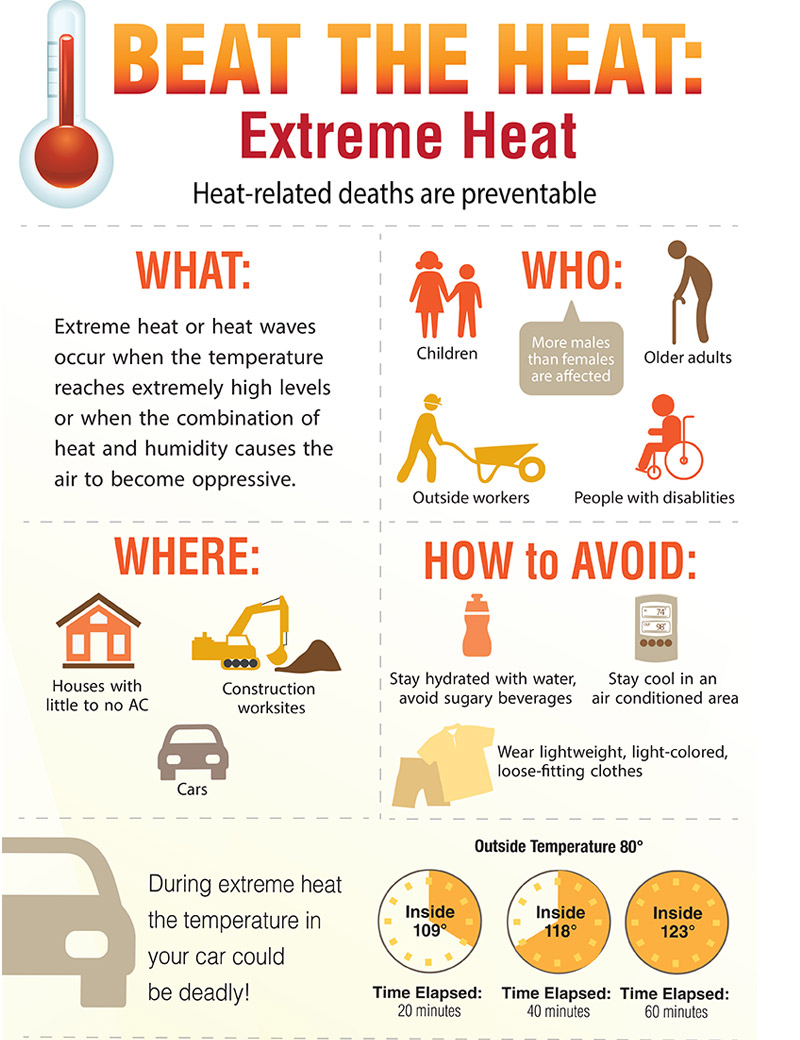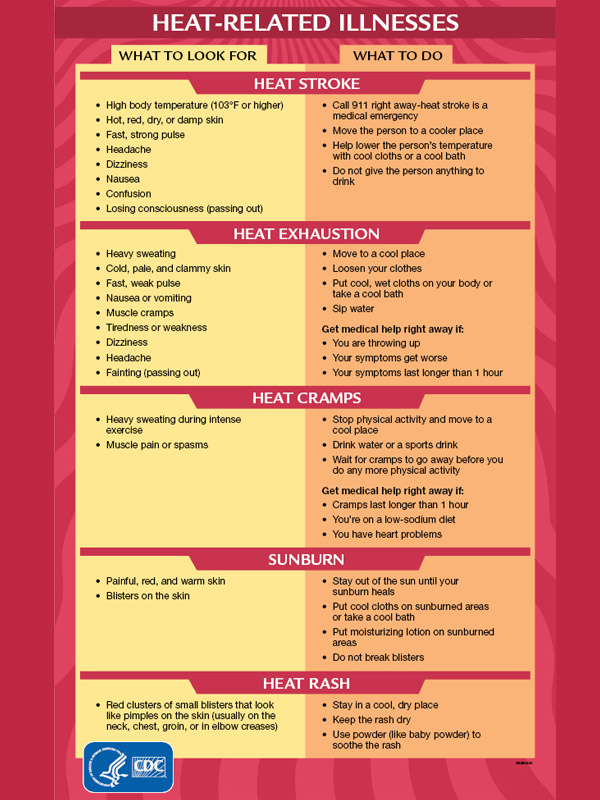Extreme Heat
Be Prepared
- Sign up for NY alerts and PREPARE NIAGARA to receive important emergency information on your phone and email.
- Create a family emergency plan and include a plan to stay cool.
- Install air conditioners and insulate around them, cover windows that receive morning or afternoon sun, and set up fans to increase air flow.
- Learn about the National Weather Service HeatRisk:
-
- This is a map-based tool available through the National Weather Service.
- The NWS HeatRisk is an experimental color-numeric-based index that provides a forecast risk of heat-related impacts to occur over a 24-hour period.
- HeatRisk takes into consideration:
- How unusual the heat is for the time of the year.
- The duration of the heat, including both daytime and nighttime temperatures
- If those temperatures pose an elevated risk of heat-related impacts based on data from the CDC
|
 |
Stay Hydrated
- Drink plenty of fluids - preferably water.
- Don’t wait until you’re thirsty to drink.
- Stay away from very sugary or alcoholic drinks—these cause you to lose more body fluid.
- Avoid very cold drinks, because they can cause stomach cramps.
- Warning: If your doctor limits the amount you drink or has you on water pills, ask how much you should drink while the weather is hot.
Never Leave Children and Pets Unsupervised in Hot Cars
There is a real and severe danger when leaving children or pets unsupervised in a car, even when temperatures don't feel hot. At 60 degrees outside, after just one hour, a closed car can get as hot as 105 degrees.
Safety Tips for Children
- Never leave a child in an unattended vehicle in warm weather, not even with the windows slightly open or down, due to the risk of heatstroke (hyperthermia).
- If you see a child in a hot car, call 911 right away and follow their instructions. Emergency personnel are trained to respond.
- Teach children not to play in or around vehicles and to alert an adult when a friend is playing in a vehicle without supervision. Make sure children understand the dangers of trunk entrapment (suffocation, heatstroke, etc.).
- Place something you need, like keys, a purse or bag, or your cell phone, next to your child's car seat so you will remember to check the backseat before you lock the car. Alternatively, place a stuffed toy in your child's car seat when not in use and move the toy to the front passenger seat when your child is in his/her car seat as a reminder that your child is in the vehicle.
- Use drive-through services whenever possible while driving with a child in a vehicle.
- It is vital to recognize the symptoms of heatstroke in children. Symptoms include absence of sweat, confusion, disorientation, flushed skin, loss of alertness, unconsciousness, or rapid/shallow breathing.
Safety Tips for Pets
- Never leave a pet unattended in the car. Like children, dogs and other animals have a harder time staying cool, leaving them extremely vulnerable to heatstroke.
- A car can overheat even when the window has been left cracked an inch or two. Parking in the shade or leaving water in the vehicle won't prevent your pet from overheating, either.
- According to the American Society for the Prevention of Cruelty to Animals (ASPCA), young, overweight, or senior animals or those with short muzzles or thick or dark coats are most at risk for overheating.
- If you see a pet in a hot car, call 911 immediately.
- Recognize the symptoms of heatstroke in pets and take action if you see them. Symptoms include restlessness, heavy panting, vomiting, lethargy, and lack of appetite or coordination.
Learn the signs and symptoms of heat-related illnesses and how to treat them.

Check on people who are at high risk
- Although anyone at any time can suffer from heat-related illness, some people are at greater risk than others:
-
- Infants and young children
- People 65 years of age or older
- People who are overweight
- People who overexert during work or exercise
- People who are physically ill, especially with heart disease or high blood pressure, or who take certain medications, such as for depression, insomnia, or poor circulation
- Visit adults at risk at least twice a day and closely watch them for signs of heat exhaustion or heat stroke. Infants and young children, of course, need much more frequent watching.
New York State Climate Impacts Assessment
New York State Department of Health - Heat Vulnerability Index
Learn more about how extreme Heat and Your Health from the CDC.
Home Energy Assistance Program (HEAP) can help eligible New Yorkers heat and cool their homes.
EPA: Climate Change and Human Health
